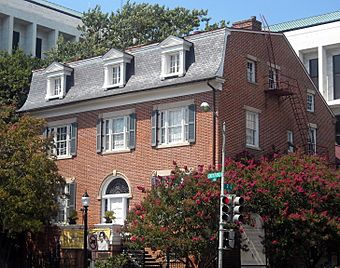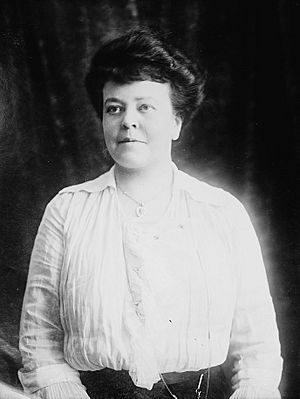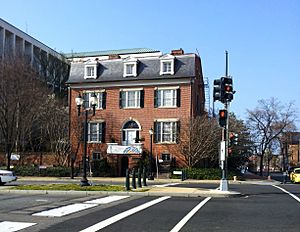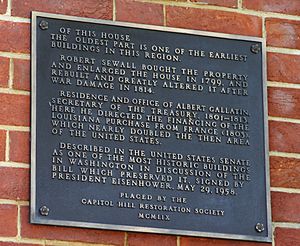Belmont–Paul Women's Equality National Monument facts for kids
|
Belmont–Paul Women's Equality National Monument; formerly Sewall–Belmont House and the Alva Belmont House
|
|
 |
|
| Location | 144 Constitution Avenue NE Washington, D.C. |
|---|---|
| Area | less than one acre |
| Built | 1800 |
| Website | Belmont–Paul Women's Equality National Monument |
| NRHP reference No. | 72001432 |
Quick facts for kids Significant dates |
|
| Added to NRHP | June 16, 1972 |
| Designated NHL | May 30, 1974 |
The Belmont–Paul Women's Equality National Monument is a historic house and museum in Washington, D.C.. It is located in the Capitol Hill neighborhood. This important place tells the story of the U.S. women's suffrage movement. This was the fight for women to get the right to vote. It also covers the equal rights movement.
The monument is named after two important leaders: Alva Belmont and Alice Paul. Both were suffragists and leaders of the National Woman's Party. Since 1929, the house has been the headquarters for the National Woman's Party. This group was key in helping women gain equal rights. The house became a National Historic Landmark in 1974. In 2016, President Barack Obama made it a National Monument.
Contents
History of the Sewall House
Building the House
The land where the house stands has a long history. In 1632, King Charles I of England gave a large piece of land in North America to Cecilius Calvert, 2nd Baron Baltimore. This land became the state of Maryland. Over many years, the land was divided and passed through different owners.
In 1790, the U.S. Congress decided to create a national capital on the Potomac River. President George Washington chose the site for Washington, D.C.. The government bought land from private owners. Robert Sewall bought some of this land in 1793 and 1799.
The main part of the house was built in 1799 and 1800. We don't know for sure who designed it. However, experts think it might have been Leonard Harbaugh, an architect from Baltimore. The house was built as an addition to a smaller farmhouse from 1750. Even though the Sewall family didn't always live there, many important government leaders did. These included Albert Gallatin, a Secretary of the Treasury, and Reverdy Johnson, a U.S. Senator.
During the War of 1812, British troops burned parts of Washington, D.C. It is believed they set fire to the Sewall house in 1814. This happened after gunfire came from the house or nearby. Robert Sewall paid to repair the house in 1820.
Changes to the House in the 1800s
The house changed over the years. After Robert Sewall died in 1820, his family owned it. In 1879, his nieces added a half mansard roof to the front of the house. This changed its look.
The house was empty for a while after 1912. Then, in 1922, Senator Porter H. Dale bought it. He made many improvements from 1922 to 1924. He added bathrooms, new floors, and renovated the kitchen.
The Alva Belmont House and Women's Rights
Becoming the National Woman's Party Headquarters

In 1921, the National Woman's Party (NWP) bought a historic building called the Old Brick Capitol. This building had been a temporary home for Congress after the United States Capitol was burned in the War of 1812. The NWP planned to use it for meetings, a library, and living spaces.
However, the government had plans to build a new United States Supreme Court Building. This new court building was going to be built exactly where the Old Brick Capitol stood. So, the NWP had to find a new home.
Alva Belmont, a wealthy supporter and co-founder of the NWP, stepped in to help. In 1927, she bought the option to purchase the Sewall house for $100,000. The NWP eventually received money for their old headquarters. In 1929, Belmont bought the Sewall house, and it became the new home for the National Woman's Party.
Renovating the Belmont House
The house was renamed the Alva Belmont House in December 1929. Renovations started to turn the private home into a place for the NWP to work and live. Women from the NWP even used bricks from the old Capitol building to pave the patio in the garden.
The renovations cost about $30,000. After the work was done in 1930, a bronze plaque was placed outside. This marked the official dedication of the Alva Belmont House. The house became a place where NWP leaders, like Alice Paul, lived and planned their work for women's equality.
Saving the House from Demolition
In the 1950s and 1960s, there were plans to build new Senate office buildings nearby. These plans sometimes threatened the Belmont House. In 1955, the U.S. Senate thought about buying the house to build underground security vaults. But people living nearby and historical groups strongly opposed this.
Later, in 1966, the Senate planned to build the Hart Senate Office Building. This plan would have taken land where the Belmont House stood. Architects wanted the land for a parking garage entrance. However, the legislation to take the land specifically protected the Belmont House from being torn down.
There was a big debate in Congress about saving the other buildings that the NWP used. Some historians argued that these buildings were also very old and important. After much discussion, the plans were changed. The parking garage entrance moved, and the NWP's buildings were saved.
Recent Renovations and Museum Status
In 1974, Congress gave the National Woman's Party money to help fix up and maintain the house. The National Park Service also started giving tours of the site. More funding for preservation came in 1984.
The Sewall–Belmont House continued to be the headquarters for the National Woman's Party. Over time, it also became a museum. It holds a large collection of items, documents, and art about the women's suffrage and equal rights movements. Keeping the old house in good condition was very expensive. The museum sometimes rented out the house for events like weddings to help pay for repairs.
Becoming a National Monument
The Belmont–Paul House is the oldest house still standing in the Capitol Hill area. It was added to the National Register of Historic Places in 1972. It was then named a National Historic Landmark in 1974.
In 2015, Senator Barbara Mikulski suggested that the National Park Service should take ownership of the house. The National Woman's Party agreed because the building was becoming too costly to maintain. Transferring ownership would help protect the site for the future.
On April 12, 2016, President Barack Obama officially named the Sewall–Belmont House a National Monument. It was renamed the Belmont–Paul Women's Equality National Monument. This new name honors both Alva Belmont and Alice Paul. The house still holds the National Woman's Party's collection. This includes a large library, archives, and museum exhibits about women's history. A generous donation from David Rubenstein also helps to restore and care for the house.
About the Belmont–Paul House
When the Sewall House was finished in 1800, it was built in the Federal style. Over the years, the house has been changed many times. Now, it has features from several different architectural styles.
The house is a rectangular shape. It is about 58 feet (17.7 meters) long on one side and 130 feet (39.6 meters) long on another. The main building has two and a half stories. The roof was originally gabled, but it was changed to a partial mansard roof in 1879. The house is made of brick.
The front of the house faces Constitution Avenue. It has three sections. The front door has special glass panels on the sides and a fan-shaped window above it. Stairs lead up to the main entrance.
A smaller kitchen addition is attached to the back of the house. A one-story stable, which is now a library, is also attached. These parts were added in the 1800s. Another addition from the 1900s created an enclosed terrace.
The windows on the front of the house have two parts that slide up and down. Each window has a stone top with a round design. There are also three dormer windows in the mansard roof. These dormers have decorative wood carvings and small pillars.
Inside, the house has a typical layout for a Federal-style home. There is a central hallway with two rooms on each side. The top floor, or attic, has a small apartment with a kitchen and bathroom. There are also narrow stairs for servants that lead to bedrooms and bathrooms on the upper floors.
Visiting the Site
The Belmont–Paul Women's Equality National Monument is located at 144 Constitution Avenue NE. It is open to the public from Wednesday through Sunday, 9:00 am to 5:00 pm. You can take a guided tour at specific times or explore the house on your own. If you have a group of 10 or more, you can schedule a tour in advance on their website. The closest Metro stop is Union Station.
Images for kids







